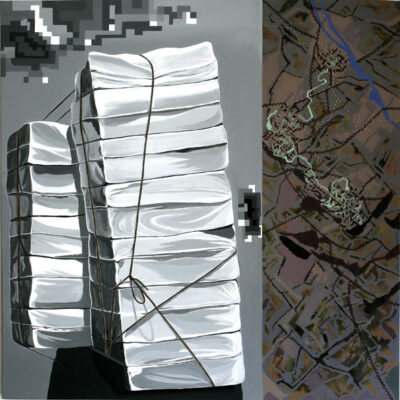
Vinay KD* emphasized his primary goal of reflecting on the rise of digital technology and urbanization as an artist. The goal was to manipulate a thread that would bring humanity to every level and capitalize the rise of technology radically. In his series of Urban Aesthetics he examined how human adaptability is affected by the rapid expansion of digitization and the uniformity of development throughout the process. Using pixels as motifs, the artist succeeded in adding depth and movement to the two-dimensional painting. The section on the left could serve as a visual metaphor for the sky scrappers and the huge buildings which India saw during its urbanization . We are becoming encircled in our desires over and over again no matter how much we strive to progress with technology and the nation as a whole. The right side of the painting contains different elements which combine to produce another layer of perception. The plane might be a scale model of a city that runs twenty-four-seven to remain at the top of the list. The race and trip are so deep that even the locals are unaware of their escapades. The lines are neither vertical, nor horizontal; rather, they create a sense of disruption and questions back at the stability of our lives, which we all rigorously lack . If we look closely, we can notice that perhaps we are all caught within the system of codes or entangled in the leashes of digitization.
In the painting, there are two worlds depicted – a world with digitization and one without. The world with pixels is a bit unsaturated in terms of colors, perhaps metaphorically describing the whole of humanity’s existence as colorless. Pixels were brilliantly used as a motif by the artist to convey utopian dimensions and a sense of uncertainty that lies within the womb of time. This painting focuses on the perception of time and digs into the unified layers representing the existence of a being in an irresistible journey through multiple lives. The painting explores the unified understanding of time, and it delves into the perception of the two worlds through an array of cognitions. Through the different perceptions and cognitions of the painting segments , we can determine the relationships between the worlds. The left (which could be assumed to be ours) seems a bit distorted and devoid of humanity, as it seems a bit chaotic, without a clear understanding of what is next. These cartons, which represent skyscrapers and buildings, where mankind dwells, are arranged diagonally, causing tension and unbalance. Urbanization has moulded us into a community of beings who nonchalantly overlook the importance of our ecosystem and systematically neglect the lives of numerous other creatures that reside and depend on it. The painting is extremely rich in terms of the painting’s shape, style and structure. The color palette plays an integral role here as it illustrates the entire tone and texture evoking utopianism within the real world. Right on, the right section is the symbol of a utopian world, the world which we humans aspire. On studying it closely, we will see how the strokes create and intersect real-world experiences in human lives that we frequently attempt to comprehend in terms of time. Since this utopian world is the dream world of every individual, it is filled with colors. Nevertheless, this painting is rich not only in its technique but also in the layered metaphors which needs artistic deciphering. The idea is to ignite a spark within the minds of people from diverse social stratums.
This series of works is highly inspired by the works of Christo Vladimirov Javacheff, where he wrapped everyday objects to focus on their form and texture and not at their content. Christo was inspired by a progressive art scene that explored all conventions, beginning to “appropriate” everyday items and deprive them of their functions, thus preserving them for posterity. Similar adaptation can be identified in these works. The significance of this painting can also be revealed from a different perspective if we rotate it 90 degrees in every direction. Considering it as an artistic expression with flexibility and vulnerability, it has a greater aesthetic impact in terms of meaning and visual tones. Aside the examination of imbalance, the work also shows control, precision, and slower movements of the brushwork, which are indicative of its content. This painting leaves a more cerebral impression than a visual one because it takes a stance on the development of a ‘being’ without trying to be a ‘being’..



